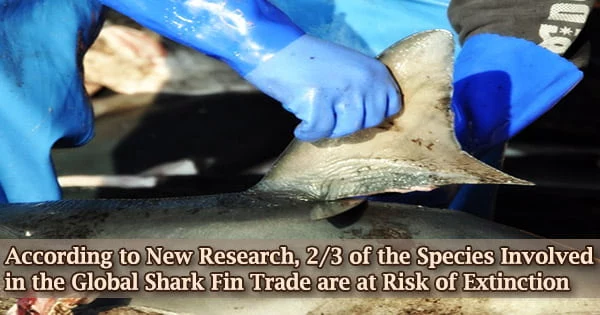According to new research, the sharks that live closest to our shores may pose the greatest threat to conservation because more than 70% of species that are used in the worldwide shark fin trade are in danger of going extinct.
9,820 fin trims were taken from markets in Hong Kong, one of the world’s main hubs for the trading in shark fins, by a group of international experts from the U.S. and China. They solved the riddle of which fin belonged to which species using some DNA sleuthing.
They discovered 86 distinct species of sharks as well as rays and chimeras, which are related to sharks. More than two-thirds, or sixty-one, of those, face extinction. The study was just released in Conservation Letters.
“Overfishing is most likely the immediate cause of the declining trends we are seeing in shark and ray populations around the world. The fact that we are finding so many species threatened with extinction in the global shark fin trade is a warning sign telling us that international trade might be the main driver of unsustainable fishing,” said Diego Cardeñosa, Florida International University (FIU) postdoctoral researcher and the study’s lead author.
Sharks and their relatives were evaluated by the International Union for the Conservation of Nature (IUCN) Red List of Threatened Species in 2021, and it was discovered that around one-third of all species were under threat. The findings of this recent study show that species involved in this trade are substantially more likely to fall under the threat category.
Dr. Demian Chapman, director of the Sharks & Rays Conservation Research Program at Mote Marine Laboratory & Aquarium and adjunct professor at FIU, has been in charge of the multidisciplinary group that works together with Cardeosa to track and monitor the international shark fin trade for almost ten years.
About 10,000 tiny pieces from processed imported fins sold in marketplaces in South China and Hong Kong have undergone DNA testing thus far. Collaboration on the project has been established with Kadoorie Farm & Botanic Garden and BLOOM Association Hong Kong. The team wants to know more about what species are traded and how widespread they are.
They will be able to advise decision-makers on the effectiveness of different management methods by monitoring this over time. According to the study, open-ocean, or pelagic, sharks like blue and silky sharks are the most frequent species to wind up in the shark fin trade.
Overfishing is most likely the immediate cause of the declining trends we are seeing in shark and ray populations around the world. The fact that we are finding so many species threatened with extinction in the global shark fin trade is a warning sign telling us that international trade might be the main driver of unsustainable fishing.
Diego Cardeñosa
However, the majority of species found in commerce and many of the most prevalent ones, such as blacktip, dusky, spinner, and sandbar sharks, are found in coastal regions. Without control, many coastal species risk extinction, the researchers warn.
“A few nations are protecting or sustainably fishing sharks and their relatives, but the majority are not for a variety of reasons,” said Chapman. “Quite a few of the coastal sharks we found in the trade such as smalltail, broadfin, whitecheek and various hound shark, river shark and small hammerhead species are listed as Endangered or Critically Endangered and yet there are no regulations protecting them anywhere in their range. Unless the relevant governments respond with management soon, we are likely to experience a wave of extinctions among coastal sharks and rays.”
Three coastal species, all of which were located in countries where shark fishing was not regulated, are already assumed to be extinct.
The Convention on International Trade in Endangered Species of Wild Fauna and Flora (CITES), an international agreement aiming to preserve animals and plants from overexploitation caused by international trade, is one strategy to promote improved species management within states.
In November, the Conference of the Parties to CITES (CoP19) will hold its 19th meeting. By bringing the predicament of coastal sharks to the attention of governments and demonstrating that just a small portion of the overall traffic in shark fins is currently controlled under the Convention, this study will provide crucial evidence for the body’s discussions.
“The upcoming CITES CoP19 Governments have tabled proposals that would bring the vast majority of sharks traded for their fins under the Convention’s sustainability controls, an action that has been informed by this study’s findings. We’re encouraged to see CITES Governments match their level of ambition to the level of threat seen for sharks and rays globally, with CITES listings a strong driver for better domestic management of shark fisheries,” said Luke Warwick, Director of Shark and Ray Conservation at the Wildlife Conservation Society.
Nations would be required to make sure that any export of listed species is lawful, traceable, and sustainable if these recommendations were to pass.
“There is a rage of management actions that nations can take to get coastal shark fishing under control and avert this extinction crisis,” said Chapman. “From changing fishing gear, to creating protected areas, to limiting catch, the solutions are out there.”
“Since our Founding Director, Dr. Eugenie Clark the Shark Lady began her work documenting shark populations in southwest Florida and around the world over 65 years ago, the core of Mote has been to push the frontiers of science in support of evidence-based, sustainable use of our shared ocean resources,” said Mote President & CEO Dr. Michael P. Crosby.
“We plan to continue this study’s vital work monitoring shark species commonly found in the trade, through the collaboration of innovative science, community-engagement, and resource management that together are critical to preventing the extinction of these species.”
“Our results highlight high levels of international trade and clear management gaps for coastal species. Many are in the highest extinction risk categories. The next category is extinction. We can’t allow this to happen,” Cardeñosa said.
This research was supported by the Shark Conservation Fund, the Pew Charitable Trusts, the Pew Fellowship Program, and the Roe Foundation.
















